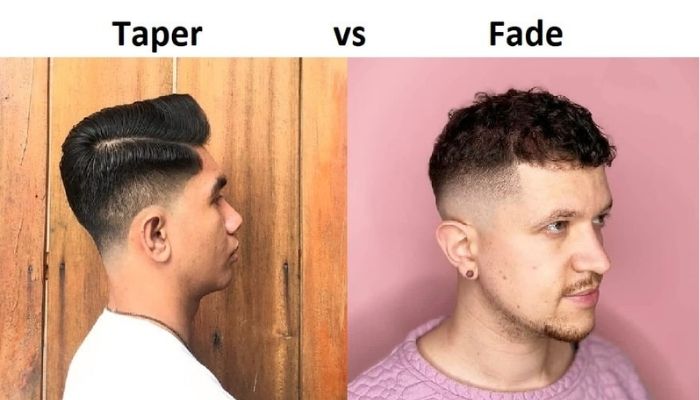Taper and low fade may look identical at first glance, but these two approaches each have their own set of benefits and drawbacks. High fade (short hair on top with longer hair growing outward) to low fade (hair gradually growing longer from the back and sides) is the most essential aspect of a fade. A taper has the same cross-sectional profile but a more compact length. Here, we’ll look at the pros and cons of both the taper and low fade haircuts so you can make an informed decision.
Taper Vs Low Fade Comparison
The detailed comparison between Taper Vs Low Fade is given below-
Consider the benefits and drawbacks of both the taper and the low fade before settling on a new style. Taper refers to a less drastic shortening of the hair on the top, sides, and back, while low fade refers to a more extreme shortening of the hair around the ears and neck.
A taper cut can be worn in many different ways, from sleek back to long on top and short on the sides to untidy spikes. The results are fantastic for giving hair volume and texture. It’s a neat detail that keeps the sides from having to be kept consistently short all the way to the top. In addition, it’s essential for achieving the layered, classic comb-over look with a side part.
Low fade haircuts, on the other hand, feature a sharp decrease in length from the beard through the blend and the shape up into the high or medium fades, creating a neat and tidy overall look. This lengthening method preserves the natural blending process while providing a striking contrast between the larger lengths on top and the shorter lengths on the sides, making it ideal for those who wish to appear modern and polished. You can’t go wrong with a low fade and a short sword cut, clean shave, or modern shaven line.
Trendy haircuts for today’s men range from the taper to the low fade, and which one a man chooses relies on his own preferences as well as other factors like his face structure and his daily routine.
Taper Vs Low Fade Difference
The key difference between Taper Vs Low Fade is given below-
- Low fade haircuts, like taper haircuts, gradually go shorter around the hairline and longer on top.
- Both the taper and the low fade gradually shorten the hair toward the nape of the neck, but the taper retains the hair longer at the crown.
- A low fade is a more subtle way to blend the short and long hair than a taper.
- When compared to the conventional taper cut, the low fade is a more modern and daring style.Low fades are the new classic for the fashion-forward man, while tapered cuts will never go out of style.
- You can use clippers or scissors to get a low fade, but you’ll need scissors to get a taper cut due of its unusual profile.
Taper Vs Low Fade Pros and Cons
The Pros and Cons of Taper Vs Low Fade is given below-
With a low fade haircut, the hair on the back and sides is kept longer than the hair on top of the head.
A taper haircut involves a subtle transition from short to long length hair.The low fade haircut is on-trend and flexible in its styling.
The taper haircut may restrict your styling options, but it is ideal if you’re going for a classic cut.
Cutting a low fade with clippers can help produce a uniform appearance, but tapering requires more careful attention to detail to preserve a natural style.
With a low fade, your facial features will stand out more clearly, and with tapering, the style’s top will continue to steal the show.
Taper Vs Low Fade- Which is better and why?
The choice between a taper and a low fade is a matter of individual preference and the desired look. A taper creates a softer and subtler look since it uses longer lengths on the sides than the top to produce a subtle blend. However, a low fade’s sides transition to a shorter length much more swiftly than those of a taper, leading to a more defined and crisp overall appearance. Because of its angular and geometrical characteristics, a low fade haircut may appeal to those who seek a more edgy appearance.
However, if you like softer lines but still want depth and volume in your hair, tapering is the way to go. Most designs are equally amenable to either approach, so picking one is a matter of personal preference.
FAQ
Q1 What is the difference between a taper and a low fade?
A1 Keep in mind that a low fade entails a much more abrupt loss of hair length at the sides and back, while a taper involves a more gradual decline in hair length from top to bottom. The low fade leaves less hair on the sides than a taper, which fades out gradually, and can therefore produce more contrast.
Q2 What kind of styling is best for a taper versus a low fade?
A2 The look and feel you want to achieve determine how you style it. Products like pomade and wax may assist those with thick or curly hair keep their cut in place for longer after receiving a haircut. For those who have naturally straight or wavy hair, additional product may not be necessary.
Q3 Which haircut should I choose if I want my hair shorter on top?
A low fade is perfect if you want your hair shorter on top since it features a distinct length difference between the top and the sides and back. A taper provides less contrast than other haircuts since it more closely mimics the development patterns of a natural hairline.
I hope you like reading on the comparison and difference between Taper Vs Low Fade.

